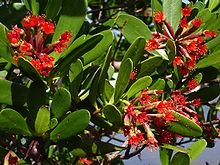Myrtales
| Myrtales Temporal range:
| |
|---|---|

| |
| Lumnitzera littorea | |
| Scientific classification | |
| Kingdom: | Plantae |
| Clade: | Tracheophytes |
| Clade: | Angiosperms |
| Clade: | Eudicots |
| Clade: | Rosids |
| Clade: | Malvids
|
| Order: | Myrtales Juss. ex Bercht. & J.Presl[2] |
| Families | |

The Myrtales are an
The APG III system of classification for angiosperms still places it within the eurosids; this is corroborated by the placement of the Myrtales in the Malvid clade by the One Thousand Plant Transcriptomes Initiative.[4] The following families are included as of APG III:[2]
- AlzateaceaeS. A. Graham
- Combretaceae R. Br. (leadwood family)
- Crypteroniaceae A. DC.
- Lythraceae J. St.-Hil. (loosestrife and pomegranate family)
- Melastomataceae Juss. (including Memecylaceae DC.)
- PsiloxylaceaeCroizat)
- evening primrose and Fuchsiafamily)
- RhynchocalycaceaeL. A. S. Johnson & B. G. Briggs)
- Vochysiaceae A. St.-Hil.
The
Ellagitannins are reported in dicotyledoneous angiosperms, and notably in species in the order Myrtales.[5]
Origins
Myrtales is dated to around 89–99 million years ago (mya) in Australasia; however, there is some contention as to that date, which was obtained using nuclear DNA. When looking at chloroplast DNA, the myrtales' ancestor is, instead, considered to have evolved during the mid-Cretaceous period (100 mya) in Southeast Africa, rather than in Australasia.[6] Although the APG system classifies myrtales as within the eurosids, the recently published genome of Eucalyptus grandis places the order myrtales as a sister to the eurosids rather than inside them. The discrepancy is thought to have arisen due to the difference between using numerous taxa versus using various genes for constructing a phylogeny.[3]
References
- ^ "Myrtales". www.mobot.org. Retrieved 2023-07-20.
- ^ hdl:10654/18083
- ^ S2CID 4392576.
- PMID 31645766.
- PMID 20162003.
- hdl:2263/58495.
Further reading
- Conti E, Eriksson T, Schönenberger J, Sytsma KJ, Baum DA (October 2002). "Early Tertiary out-of-India dispersal of Crypteroniaceae: evidence from phylogeny and molecular dating". Evolution; International Journal of Organic Evolution. 56 (10): 1931–42. PMID 12449480.
- Schönenberger J, Conti E (February 2003). "Molecular phylogeny and floral evolution of Penaeaceae, Oliniaceae, Rhynchocalycaceae, and Alzateaceae (Myrtales)". American Journal of Botany. 90 (2): 293–309. PMID 21659121.
External links
![]() Data related to Myrtales at Wikispecies
Data related to Myrtales at Wikispecies
